An interview with co-creator Gerry Conway…
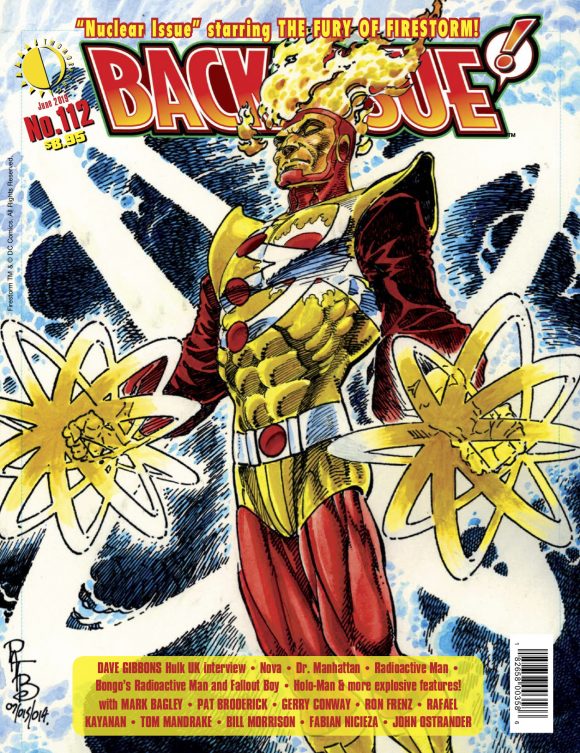
Y’know what character we’ve hardly featured at 13th Dimension? Firestorm.
Just one of those things, I suppose. I’ve long dug the character – I was a big reader of the ’80s series The Fury of Firestorm – but I’ve never really focused on his initial ’70s run, which was cut short by the infamous DC Implosion. (Click here for much more on that.)
Anyway, the new Back Issue #112, due May 8, is dubbed the “Nuclear Issue” and the cover boy is ol’ Matchstick himself, giving us the opportunity to explore the roots of this Bronze Age creation with an EXCLUSIVE EXCERPT from the mag — an interview with co-creator Gerry Conway.
But before we get to that, check out the table of contents to get a sense of what else the ish has to offer:

Cool, right? Right.
Back to Conway, though. Cecil Disharoon’s The Firestorm Interviews feature discussions not just with the co-creator but editor Jack C. Harris; co-creator and artist Al Milgrom; succeeding artists Pat Broderick and Rafael Kayanan; and succeeding writer John Ostrander.
It’s terrific stuff, so pick up the full issue.
In the meantime, dig this (slightly edited) EXCLUSIVE EXCERPT, as Conway reveals Firestorm’s origins – and how they relate to his time at Marvel:
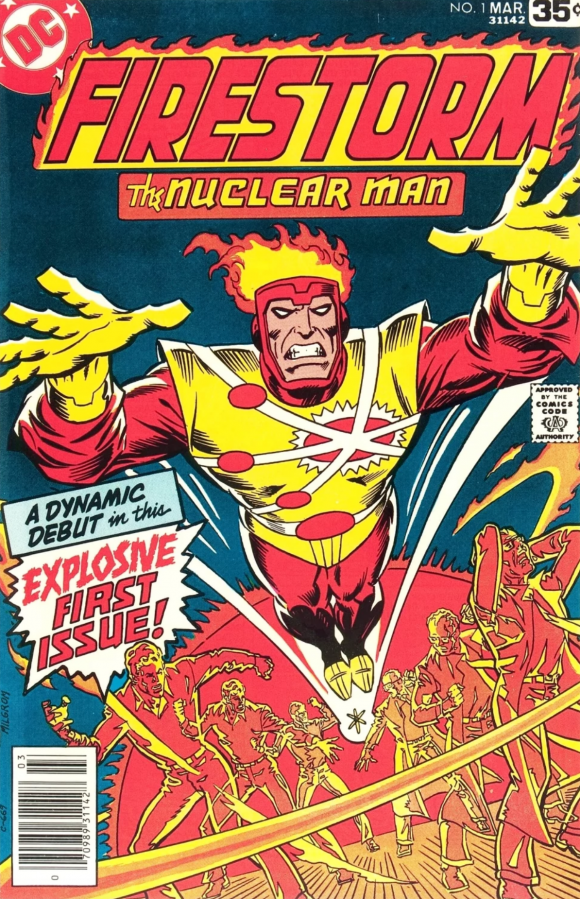
Al Milgrom
By CECIL DISHAROON
Always a storyteller and reader, Gerry Conway made his own comics from childhood: “I don’t recall an epiphany where I decided to become a writer… I just always wanted to be a writer,” says Gerry, who then made a prolific life of this innate urging, beginning to be published while in his teens.
Already a published science-fiction novelist when he began writing for first, DC, and soon, Marvel Comics, at age 19, Conway was tapped to relate Peter Parker to the times as the new scribe of The Amazing Spider-Man.
“I watched anything and everything I could get my hands on related [to Marvel],” he reveals to Back Issue, including the 1967 Spider-Man cartoon. Perhaps this approach — “a comedy that happened to feature an action hero” — influenced Conway creatively; he had also been reading Amazing Spider-Man “from Issue #2 or 3.”
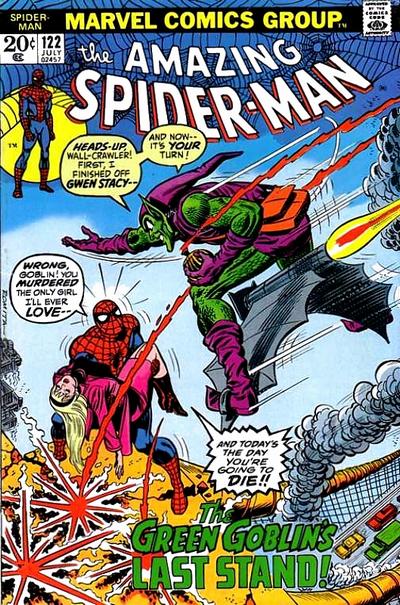
Gerry Conway wrote the death of Gwen Stacy. But you knew that.
The productive scribe was entrusted with about a title a week, during a period where Roy Thomas served as the single editor of Marvel’s 40-title line — a time when writers, Conway says, excepting some care from the assistants, were pretty much their own editors. Gerry’s memorable contributions to the Spider-Man title are well documented, but before long, he had the Marvel approach nailed — he’d even helmed the line himself as Marvel’s editor-in-chief for one month in 1976 — by the time he jumped ship for rival DC again.
The layered roll-out of the early Marvel Universe, its Villain of the Month boom, and the success of the Amazing Spider-Man title Conway took over from Stan Lee all inspired Gerry’s Firestorm approach. His stay at DC generated what’s called “Conway’s Corner,” a proliferation of short-lived titles and characters with long-lasting connections to the DC Universe: the villainous Kobra, Power Girl, the JSA revival, the Freedom Fighters, and the Secret Society of Super-Villains. With a new creative incentive in the works thanks to DC’s new publisher, Jenette Kahn, Gerry reached for a Promethean light, around which he oriented a genuine attempt to spin a Marvel style of character off into the world of DC.
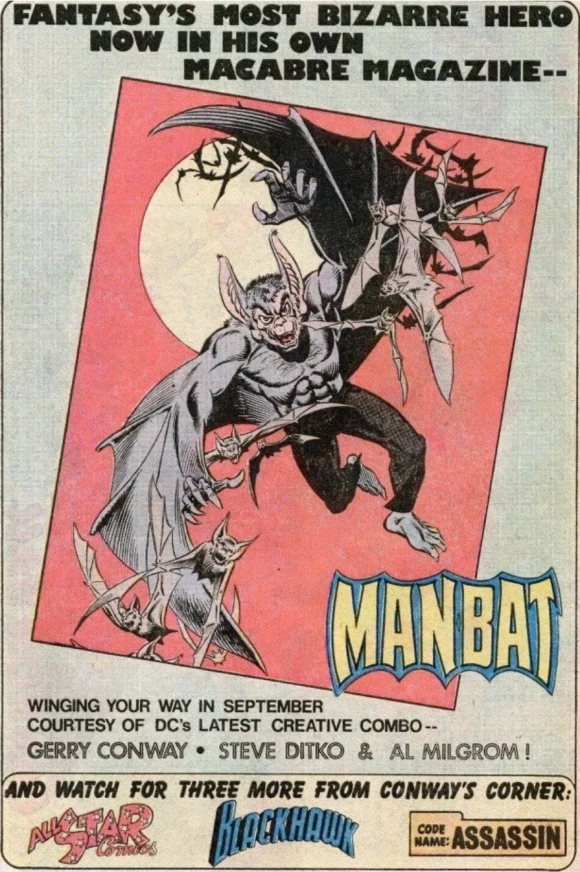
DC house ad touting “Conway’s Corner”
Cecil Disharoon: How did you create the Firestorm dynamic?
Gerry Conway: I’d been playing around with the idea of a teenage superhero for DC, who could sort of fill the hole that had been left in my heart by leaving Spider-Man behind. I’d been thinking about the tropes — one of which was the meek, mild alter ego, the brainy kid who, in wish fulfillment, gets superpowers, is extremely powerful… able to do things that he hadn’t been able to do before. That was, I think, the major motivating force—I wanted to play on that trope.
To do that, I wanted to flip it around: create a guy who wasn’t the brightest guy in the room, the not-terribly-smart guy who became a superpowered character. The way I’d make that work: I’d bring him into contact with the smarter person, who would also share the powers. This led to… the multiple-people-in-one, Professor Stein/ Ronnie Raymond dynamic.
Disharoon: When did this “fire-in-the-mind” — the archetype of a flaming-headed person — click together with this character-driven approach?
Conway: I always loved the idea of the hair on fire — I think it goes back to Johnny Storm, the Human Torch, an entire flaming character, of course. I created (Galactus’ herald) Firelord — I actually sketched out his costume. I was really taken by the idea of the flaming head.

Milgrom
Disharoon: A herald of Galactus was obviously a world away from Ronnie Raymond.
Conway: Right! I think that the two notions, the fire-based character, and—you’re talking two characters that are merging as one, that’s a “fusion.” “Fusion” leads to “nuclear”; “nuclear” leads to words like “firestorm,” a term for what would happen in a nuclear blast — it all sort of came together organically. I don’t know where you can really separate out where the different elements took priority, where any of it came first.
Disharoon: Along with a creative reaction to the early Marvel Age, your growing up in the infamous shadow of “the bomb” seems part of the initial spark of Firestorm.
Conway: This was around the time, I believe, of Three Mile Island [Interviewer’s note: actually, pre-dating that accident, which occurred in late March of 1979], The China Syndrome. There was a lot of condemnation of nuclear power, in general—much of it, I think, overblown, in a hysterical time, such as we are now.
Disharoon: What a way to tap into the most fearsome of words, for the conflagration itself: Firestorm!
Conway: Sure! At the same time, make it fun and friendly.
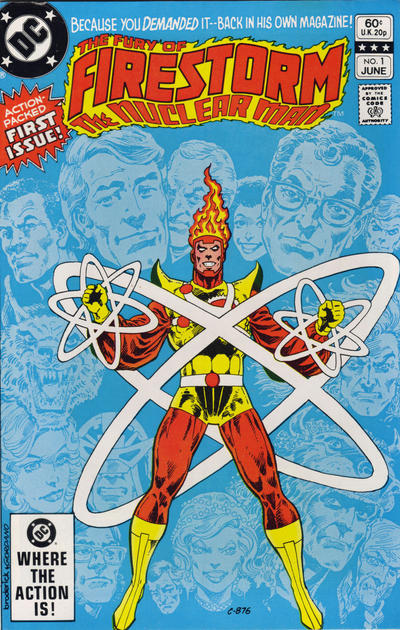
1982’s revival. Pencils by Pat Broderick, inks by Dick Giordano.
Disharoon: I’ve reflected on how the title becomes The Fury of Firestorm, but the character’s known best for “the funny of Firestorm.”
Conway: Yeah! He’s a kid… and a somewhat silly kid, with a somewhat childish or adolescent approach to problem solving. That makes him fun, and I wanted the book to be fun, the way writing Spider-Man can be fun. If the point was missed in any of the book’s revivals in later years, it’s been by making it darker, grimmer. And perhaps by avoiding the archetype of the adult, sitting on the shoulder of the adolescent, second-guessing him.
Disharoon: I’d intended to ask if Firestorm was in any way a reaction to Nova at Marvel — but I suspect he’s more of a contemporary reaction to the original inspirations (like the Human Torch and Spider-Man). Was Solar, and Dr. Raymond Solar, from Gold Key, anywhere in your thinking?
Conway: Not really! I was aware of it, but Gold Key books were so dull and boring. I don’t think they had any influence on me at all.
One of the things that makes Firestorm work — the reasons he’s remained a popular character for decades — it’s a combination of the very colorful costume and powers, but also the fundamental character. The archetype of the young person and the adult, overseeing and interfering. It’s a situation we easily relate to.
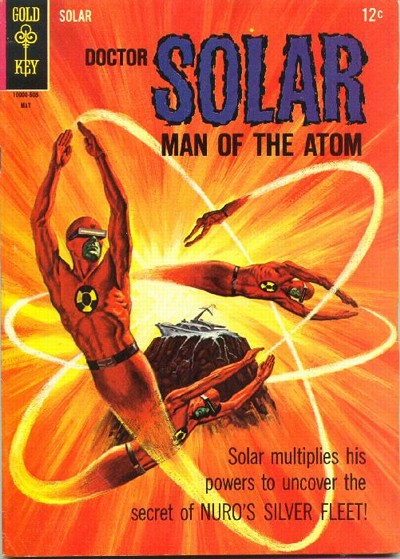
Disharoon: You, as the young comics creator, a writer, had this archetype with these transmutational abilities. You came into the business, knowing that you and this artist on this page could create any scenario… do things Hollywood could then only dream of. You also had older mentors, like the one and only Stan Lee, and John Romita Sr. You worked with [DC editor] Julius Schwartz. So, you had those older, editorial advisors in the background, to caution your direction.
Conway: That’s true, but that’s a very specific example. The larger reality is, that’s exactly how every adolescent feels! There’s not one who doesn’t have an adult looking over their shoulder, in some sense… that “voice in their head” that’s second-guessing them. It’s not specific to being a young creator working with an older editor: it’s specific to being a human being! (Laughs)
Disharoon: So many of your readers were younger than Ronnie, or were his age…
Conway: Exactly! At this point in the ’70s, we didn’t have the massive influx of adult comic readers we have now. I would say more than 90% of our readers were teenagers or younger! That was the audience we were trying to reach. By the necessities of the market, comics are not aimed at kids anymore!
Disharoon: Was it the fusion/fission idea that led to the outrageous notion of this two-person identity?
Conway: I don’t know! Things just work out in the process of an idea. All of that just… came together. It’s really hard to parse it out.
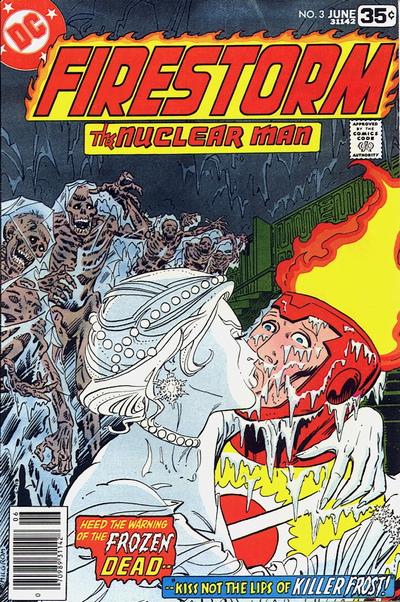
Milgrom
Disharoon: How did you decide to write about a wise-cracking hero? Is this something about Gerry Conway?
Conway: Well, yes, I’m basically a wiseass. I make jokes at the most inappropriate moments and situations, and I like writing those kinds of characters. That’s what I always loved about writing Spider-Man. I’ve always been the “smart” guy making the “smart jokes”— you know, getting himself into trouble! (Laughs)
Disharoon: How better to poke holes in perceptions?
Conway: I think that’s fundamental for most any writer, but my particular bent has always been to make fun of things. I’ve always felt — and this may’ve offended some of my readers, in my day — that one of the most fundamentally wonderful things about superheroes is that they are just silly. The very idea of the superhero — the superhero powers and fantasy — all of it is silly! And I don’t say that in a negative way. I think that’s what makes them wonderful, because they’re detached from reality. That detachment from reality allows you to do things that a more “realistic” approach doesn’t allow. You can do absurd things, and absurdity is social commentary, in certain ways. It can give you license to say, “The emperor doesn’t have any clothes.”
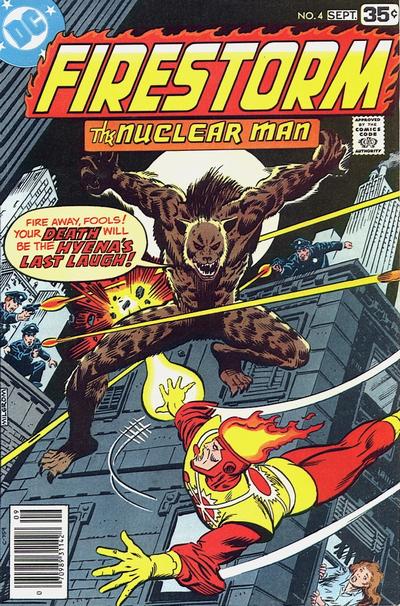
Milgrom
Disharoon: I was looking at Firestorm Issue #6, from the Cancelled Comics Cavalcade, and other issues from your run in 1978. Every couple of pages, you were laying out subplots you could pursue down the line: the stuff with Ed Raymond and the Shines mob; one of the Shines becomes Typhoon; Summer Day is introduced (in #4) and is really the Hyena; Cliff Carmichael tries to put Ronnie in his place in a badly managed classroom; Jefferson (later Jackson) sticks up for Ronnie and accidentally humiliates him, because he doesn’t know he’s struggling for his identity, and should he stand up for himself as Ronnie or Firestorm… I love it! Some of the density, I know, was part of the times… but you would seed so many subplots, and keep the lives of the supporting characters vital.
Conway: Part of what you’re talking about are techniques I learned from John Romita, when we worked on Spider-Man together — touching base with supporting-cast characters, creating loose threads that can provide story opportunities in the future. Back then, when you’re doing a monthly book, you’re under pressure to create premises for future issues. The way to do that is to leave yourself with an unresolved issue in a subplot, a strand that you can pluck (laughs), tie into the ongoing story.
Disharoon: Like cooking a several-course meal. Considering the sheer number of titles you wrote back then, it’s remarkable that you were that coherent! I heard a comment you made on the Fire & Water Podcast about the demands of writing television, generating so much material that may or may not be used. Do you meditate? Any tricks?
Conway: I wasn’t that sane (laughs). I was overworked and frazzled through most of my 20s and early 30s, to the point where I developed a sort of writer’s block. I ended up working with my wife at the time (Carla Conway) for helping with scripts.
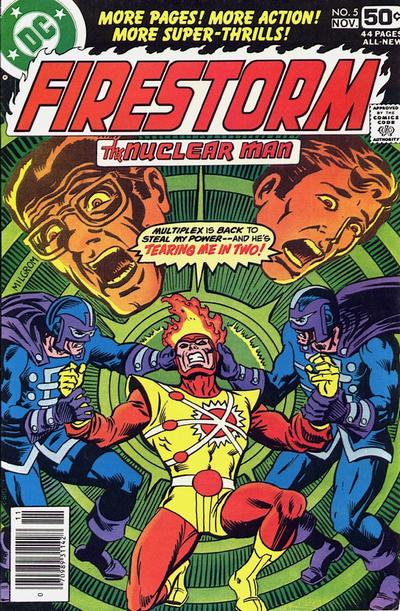
Milgrom
Disharoon: I wasn’t sure if that was by design, or more from sheer necessity.
Conway: Oh, I’d say about 95% of that was by sheer necessity! At the same time I was doing comics, I was writing treatments for films, with Roy Thomas. By the time it was the early ’80s, I was having trouble doing the same amount of work, but by then, I felt the need to do it for financial reasons.
Disharoon: You were writing Firestorm with the intention of making a lighter-hearted strip. Were you able then to dispel the negativity that came from overwork?
Conway: No, I wasn’t able to dispel it. (Laughs) That’s why I finally had to get out of the business.
I’m married to a writer now, and it works out pretty well, because we’re both crazy.
—
MORE
— George Perez’s FIRESTORM. Click here.
— THE DC IMPLOSION: Inside Cancelled Comic Cavalcade. Click here.
—
Back Issue #112 is due out May 8. You can get it at your local comics shop or directly from TwoMorrows. (Click here.)

May 5, 2019
This is a pretty hot post for the Firestorm character.